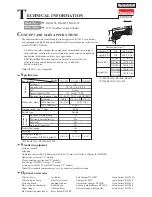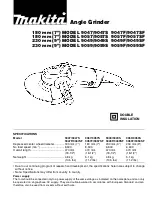
77
76
EN
EN
MEANINGS OF MARKINGS ON THE LABEL
OF THE CHARGER
Protect the charger against rain,
high humidity and the entry of
water. Use indoors.
Product with protection class II.
Safety protective transformer that is
safe in the event of a malfunction.
Socket (connector) intended for
charging with direct current.
220-240 V
~50 Hz
Input voltage and frequency
20 V / 2.4 A
Output (charging) voltage and
current.
Table 2
Note regarding table 2:
The meaning of other pictograms that are identical to
the pictograms shown on the cordless power tool are
explained in table 4.
X. Additional safety
instructions
for the battery
y
Protect the battery against rain, frost, high humidity,
temperatures above 50°C, against mechanical damage
(e.g. being dropped) and never open or burn it. Prior
to storing the cordless power tool, take the battery out
of it and charge it fully. Store the battery fully charged
and removed from the power tool, and to ensure the
longest possible lifetime fully charge it after several
months (no later than after 6 months).
y
Protect the battery contacts against soiling, deforma
-
tion or other damage and prevent conductive bridging
of the battery contacts by taping over the connectors,
e.g. using plastic tape, to prevent the battery from
short-circuiting, which could result in a subsequent fire
or explosion.
y
Ensure that children do not play with the battery.
MEANINGS OF MARKINGS ON THE LABEL
OF THE BATTERY
Max. 50˚C
Max. 50˚C
Do not expose the battery to direct
sunlight and temperatures over
50°C.
Do not burn the battery.
Prevent the battery from coming
into contact with water and high
humidity.
Do not throw the battery out with
household waste, see subsequent
paragraph about waste disposal
20 V
Terminal voltage of a fully charged
battery without load.
2 000 mAh
Battery capacity.
Table 3
Note regarding table 3:
The meaning of other pictograms that are identical to
the pictograms shown on the cordless power tool are
explained in table 4.
e)
Panels and other large workpieces need to be
supported from underneath to reduce the risk
of jamming the disc and kickback.
Large workpie-
ces have a tendency to buckle under their own weight.
Supports must be placed underneath the workpiece near
the cutting line and near the edges on both sides of the disc.
f)
It is necessary to pay special attention when
„cutting into a cavity“ on existing walls or
other blind areas.
The penetrating disc may cut gas
or water pipes, electrical conduits or items that may
cause kickback.
ADDITIONAL SAFETY INSTRUCTIONS
FOR PLANAR SANDING/GRINDING
WORK TASKS
SAFETY WARNINGS SPECIFIC
TO WORK ACTIVITY RELATED TO
PLANAR SANDING/GRINDING:
a)
An excessively large sandpaper is not used with
the sanding plate. When selecting a sandpaper,
it is necessary to follow the manufacturer‘s
recommendations.
A large sandpaper that extends
past the perimeter of the sanding plate risks tearing and
may cause jamming, tearing of the disc or kickback.
ADDITIONAL SAFETY INSTRUCTIONS
FOR WIRE BRUSH GRINDING WORK TASKS
SAFETY WARNINGS SPECIFIC
TO WIRE BRUSH GRINDING WORK TASKS:
a)
Even during standard activity, wire bristles are
ejected from the brush. The wires must not be
overloaded by excessive pressure on the brush.
Wire bristles can easily penetrate through light clothing
and/or skin.
b)
In the event that the use of a guard is reco-
mmended for use with the wire brush, ensure
that there is no contact between the wire disc
or brush and the guard.
The wire disc or brush may
during work due to the effect of load and centrifugal
forces increase its diameter.
The cordless power tool creates an electro
-
magnetic field during operation, which
may negatively affect the operation of
active or passive medical implants (pace
-
makers) and threaten the life of the user. Prior to using
this power tool, ask a doctor or the manufacturer of the
implant, whether you may work with this power tool.
y
Do not use the cordless power tool for a purpose other
than that for which it was designed. Do not modify the
saw for different applications.
y
When using the cordless power tool, use certified eye
and ear protection and gloves with a sufficient level of
protection, and when cutting materials during which
dust is generated, also protection of the respiratory
tract (consult the necessary level of protection at
a personal protective aids store). Inhalation of dust is
damaging to health.
IX. Safety instructions
for the charger
y
Read the user‘s manual before charging.
y
The charger is intended only for charging indoors. It is
necessary to protect it against rain, high humidity and
temperatures over 40°C.
y
Prevent the charger from being used by persons
(including children) whose physical, sensory or mental
disability or incapacity or insufficient experience or
knowledge prevents them from safely using the appli
-
ance without supervision or instruction. Children must
not play with the appliance. It is generally not assumed
that the charger will be used by very small children (age
0- 3 years inclusive) and used by small children without
supervision (age between 3 and 8 years). It is conceded
that seriously handicapped persons may have needs
outside the level specified by this norm (EN 60335).
y
When charging, provide for ventilation since fumes may
be released from the battery if it is damaged as a result
of incorrect handling.
y
Charge the battery at temperatures in the range 10°C
to 40°C.
y
Protect the charger and its power cord against damage.
Protect the charger‘s charging terminals against con
-
ductive bridging when the charger is under voltage,
otherwise there is a risk of short circuiting. Protect the
plug of the power cord against deformation or other
types of damage.


































